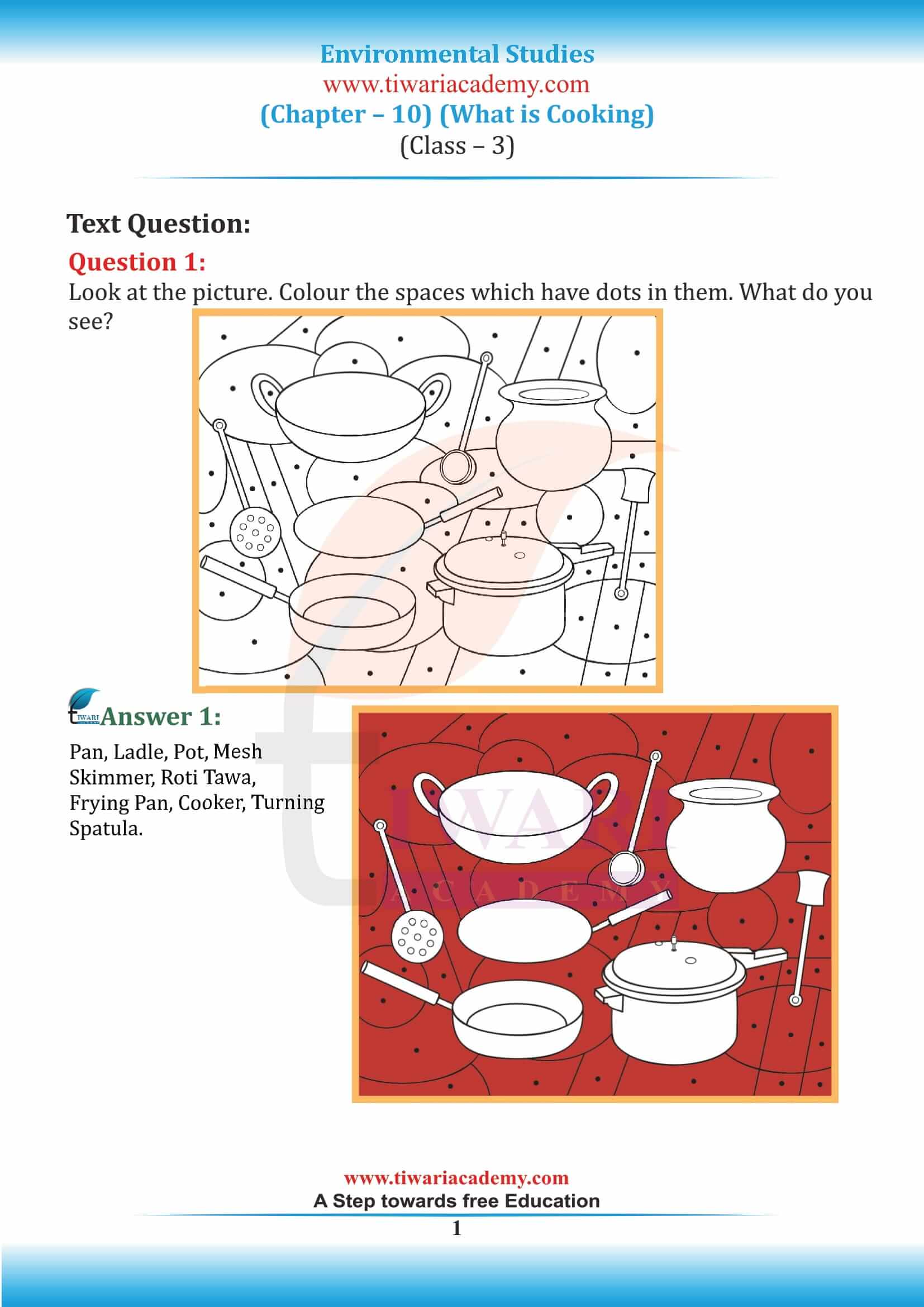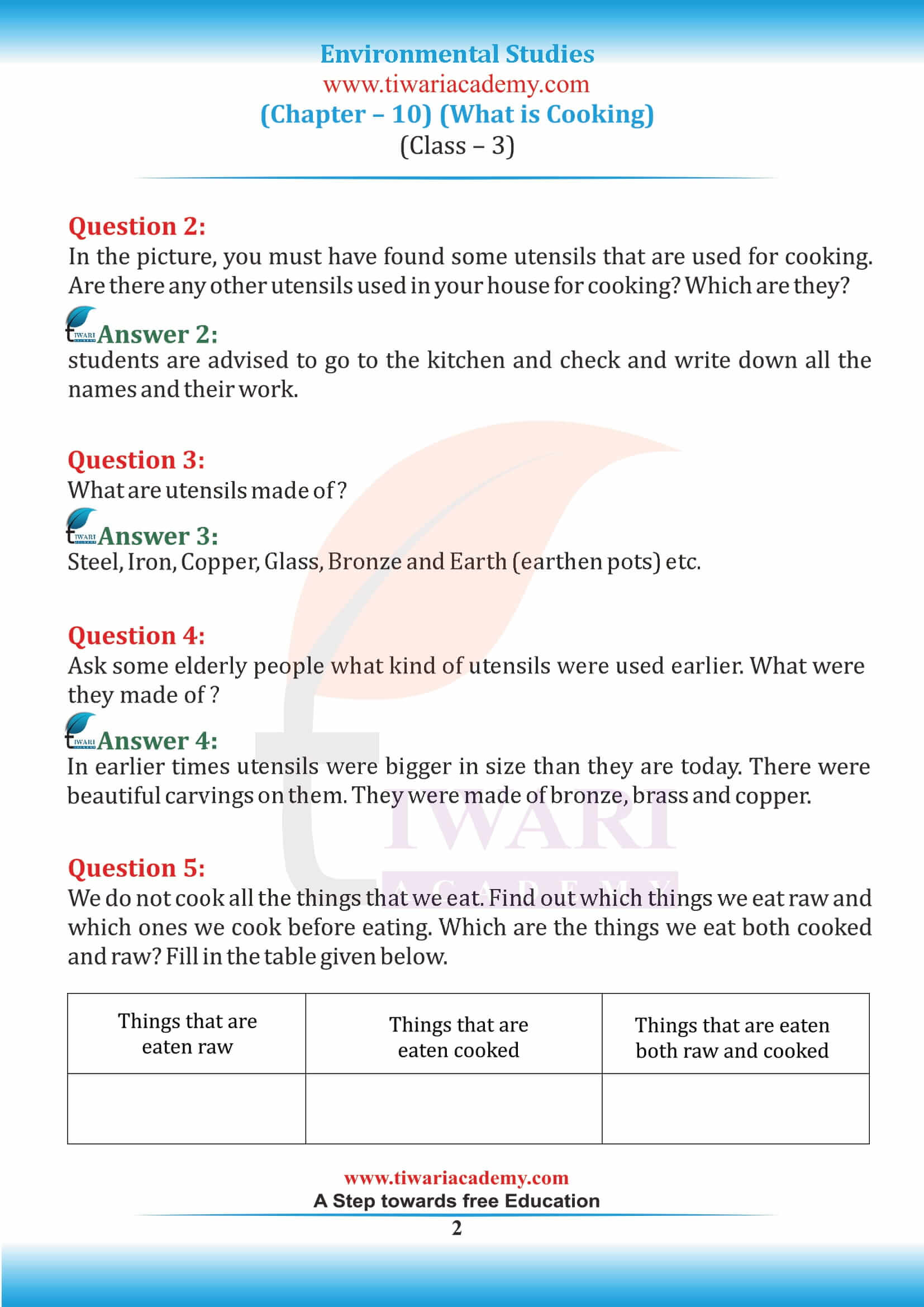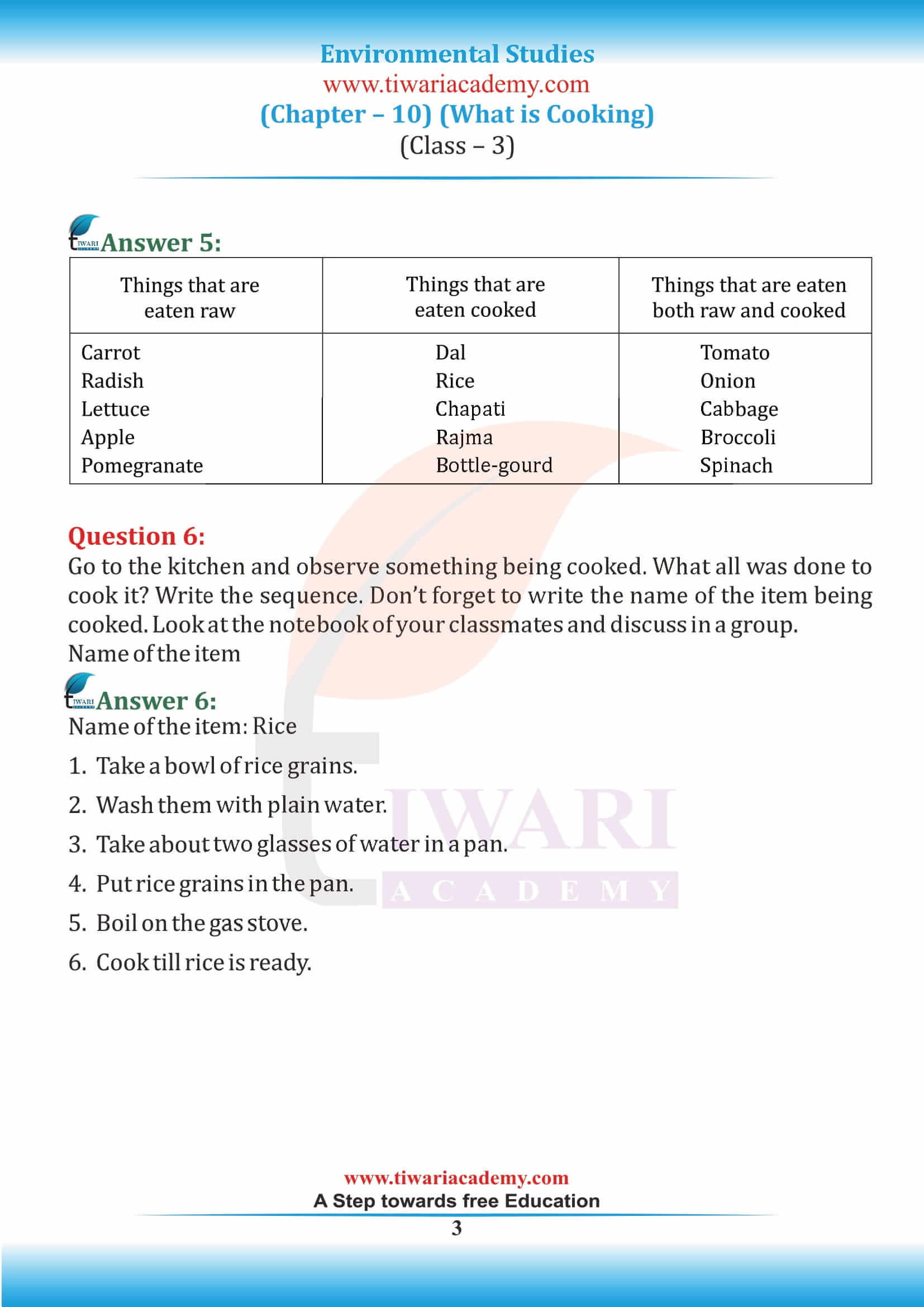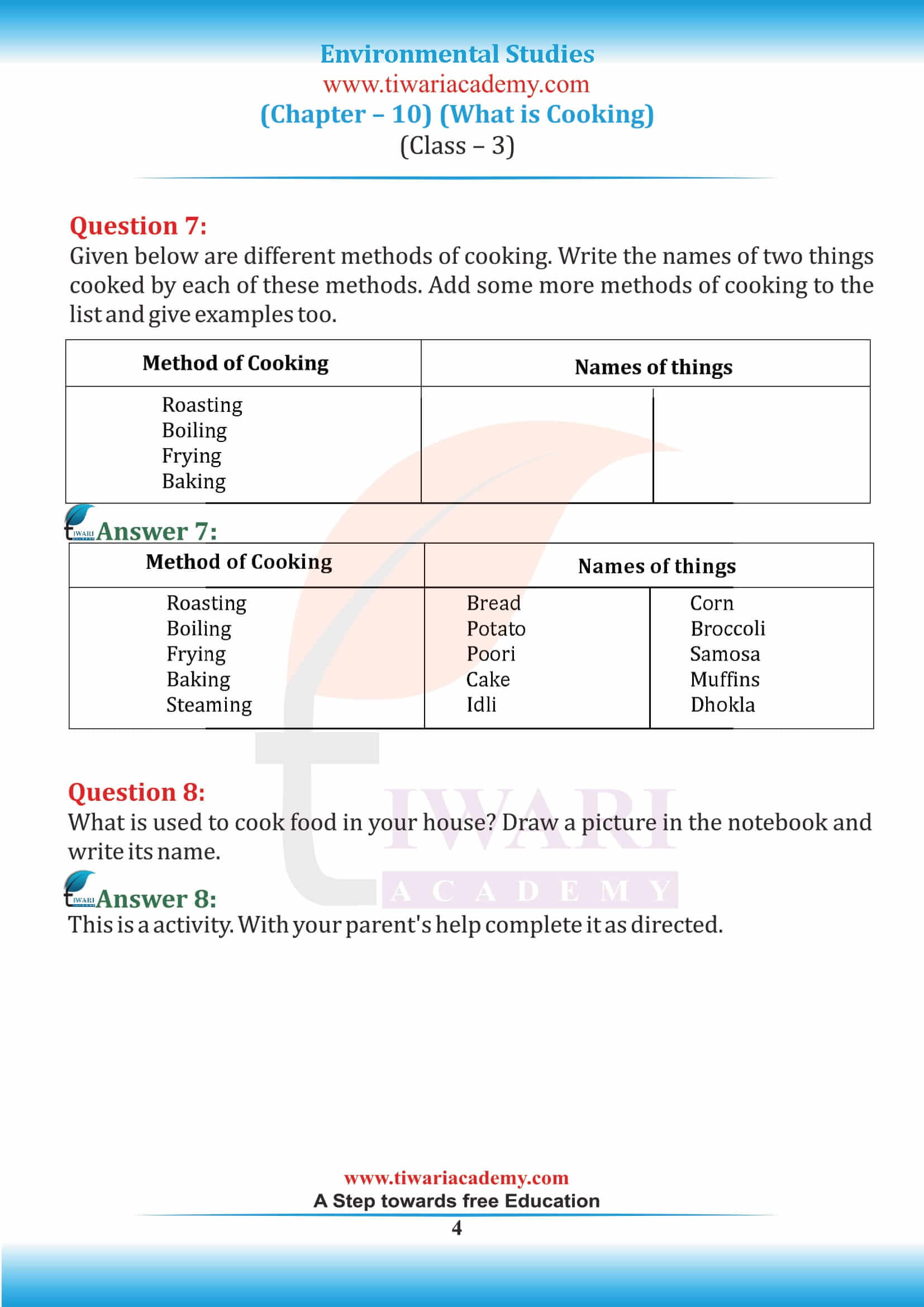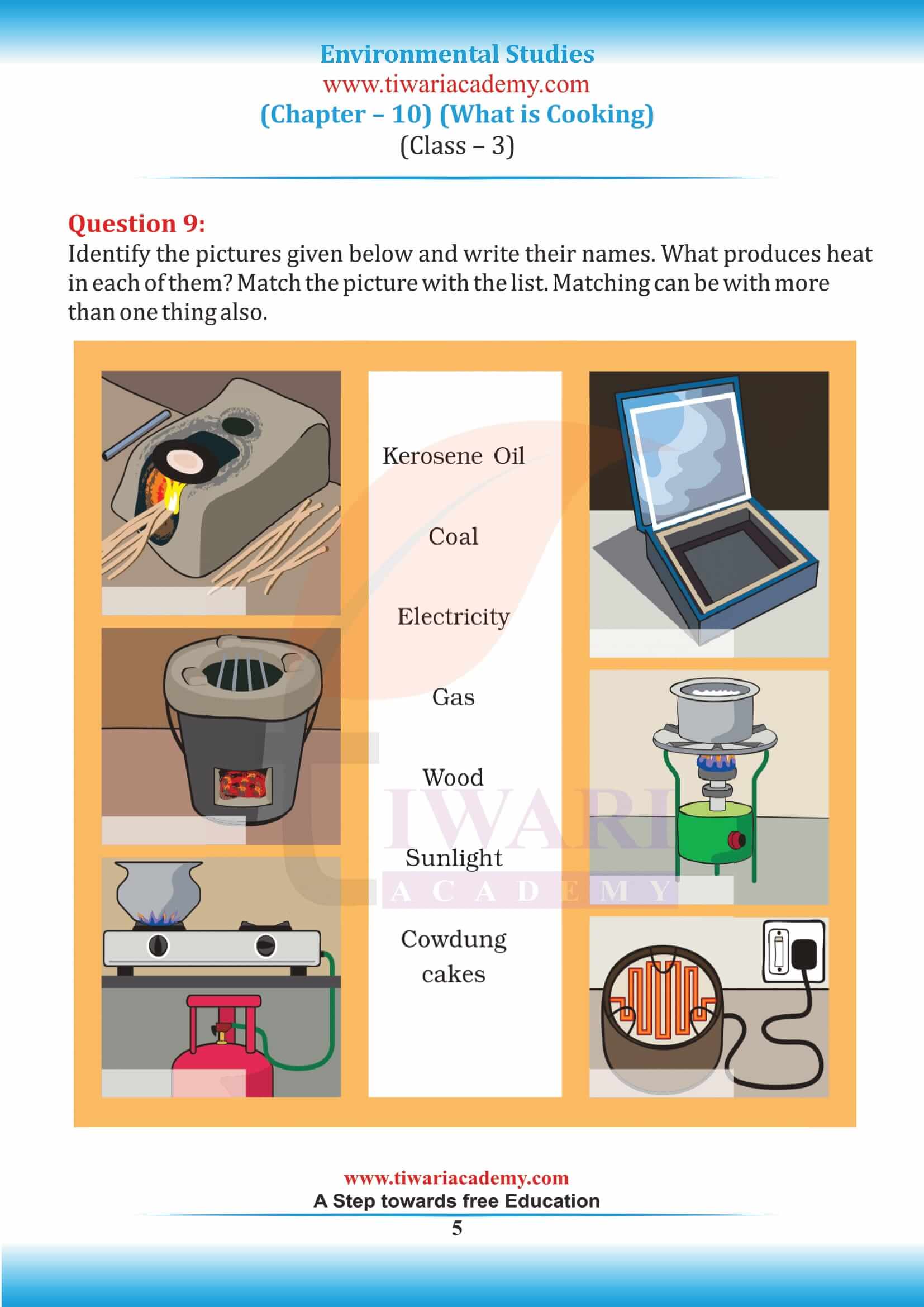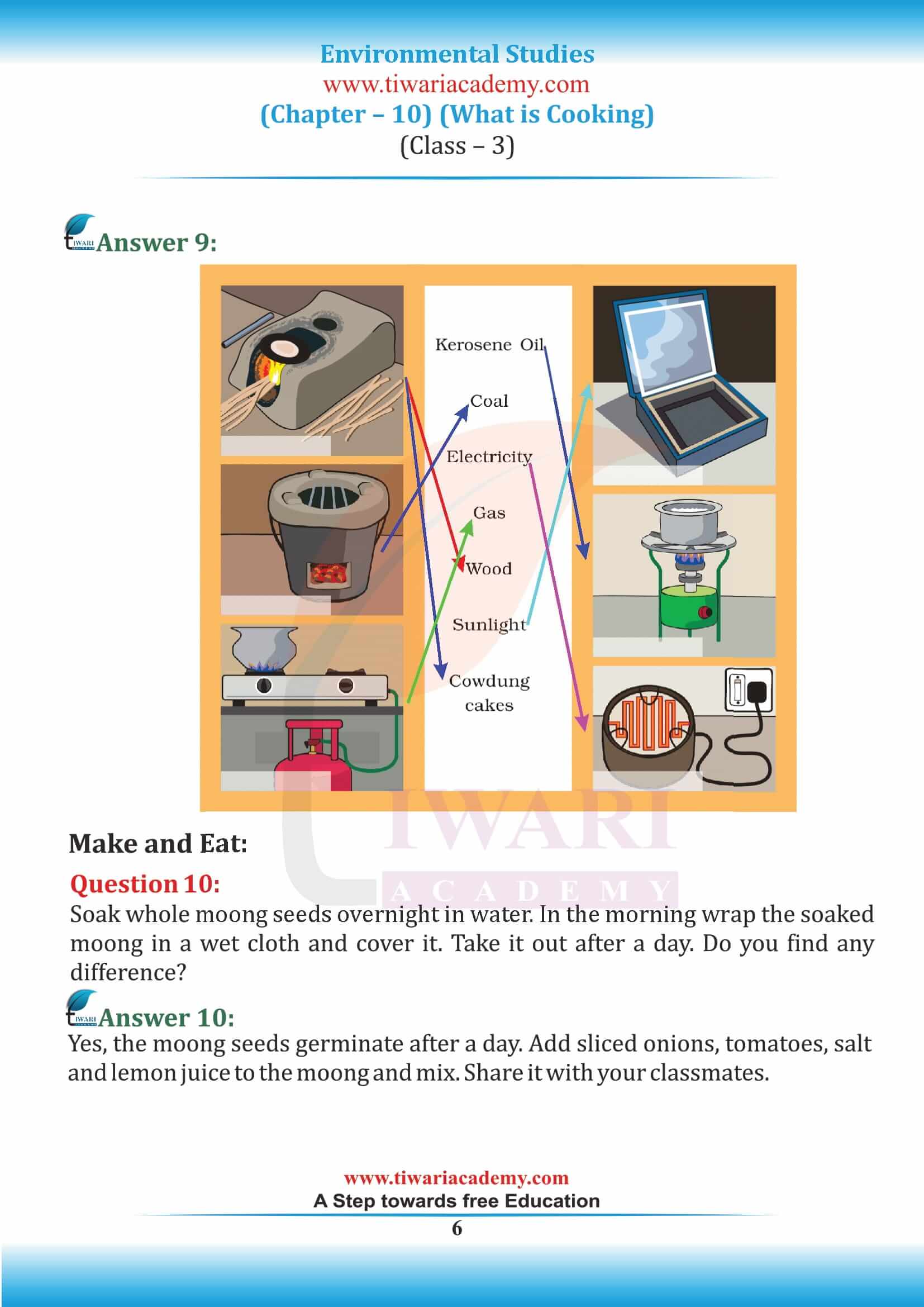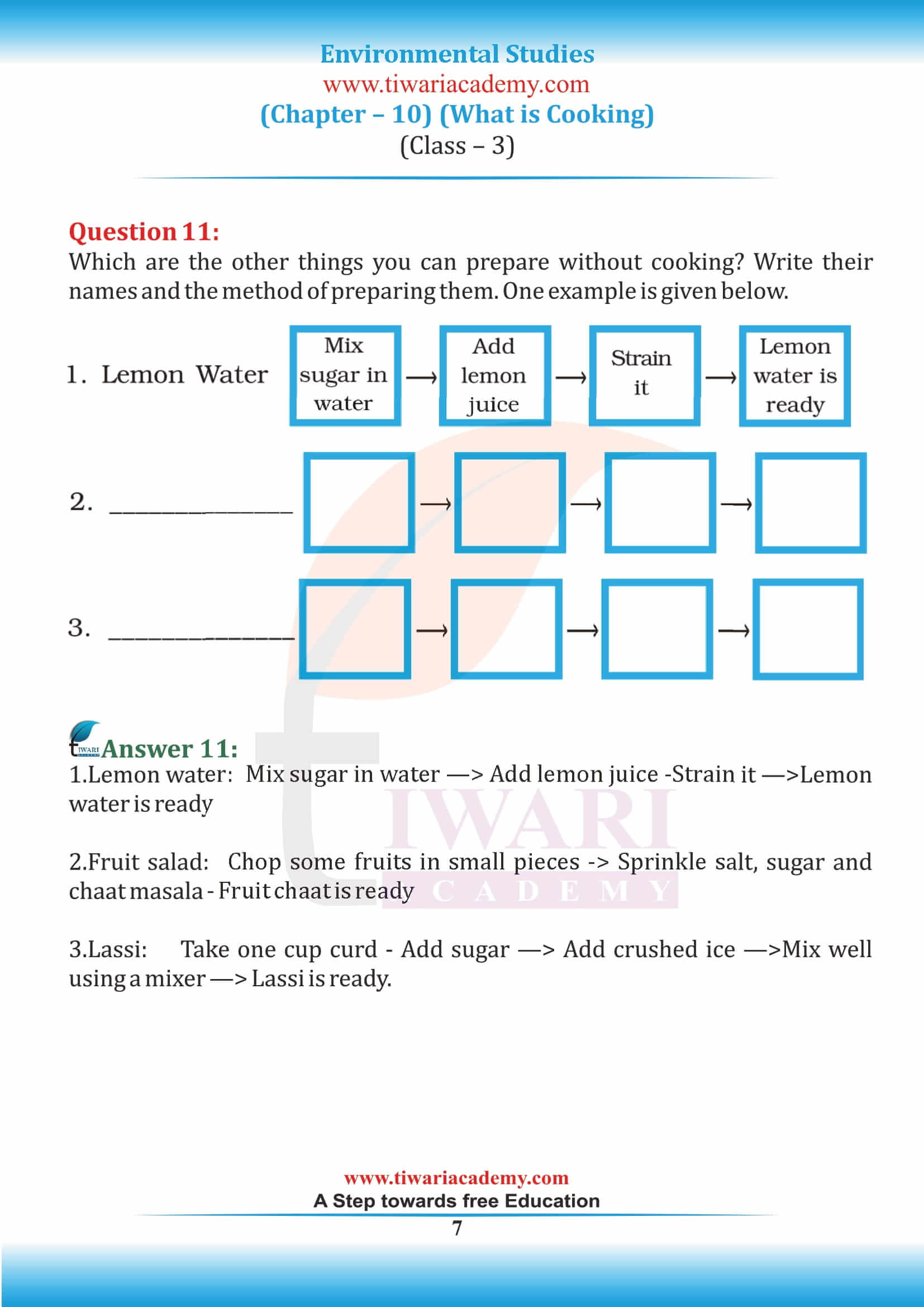NCERT Solutions for Class 3 EVS Chapter 10 What is Cooking in Hindi and English Medium solution from new NCERT Text Book Environmental Studies Looking Around updated for new session 2025-26. Class 3 EVS Chapter 10 helps us to know about the different utensils used in Kitchen. All the questions given in chapter are solved in simple format using pictures and text. Get here NCERT Grade 3 EVS Chapter 10 Solutions free.
NCERT Solutions for Class 3 EVS Chapter 10
NCERT Solutions for Class 3 EVS Chapter 10 What is Cooking
NCERT Exercises Answers for Class 3 EVS Chapter 10
Look at the picture. Colour the spaces which have dots in them. What do you see?
Pan, Ladle, Pot, Mesh Skimmer, Roti Tawa, Frying Pan, Cooker, Turning Spatula.
What are utensils made of?
Steel, Iron, Copper, Glass, Bronze and Earth (earthen pots) etc.
Ask some elderly people what kinds of utensils were used earlier. What were they made of?
In earlier times utensils were bigger in size than they are today. There were beautiful carvings on them. They were made of bronze, brass and copper.
Question:
We do not cook all the things that we eat. Find out which things we eat raw and which ones we cook before eating. Which are the things we eat both cooked and raw? Fill in the table given below.
Answer:
| Things that are eaten raw | Things that are eaten cooked | Things that are eaten both raw and cooked |
|---|---|---|
| Carrot | Dal | Tomato |
| Radish | Rice | Onion |
| Lettuce | Chapati | Cabbage |
| Apple | Rajma | Broccoli |
| Pomegranate | Bottle-gourd | Spinach |
Question:
Go to the kitchen and observe something being cooked. What all was done to cook it? Write the sequence. Don’t forget to write the name of the item being cooked. Look at the notebook of your classmates and discuss in a group.
Answer:
Name of the item: Rice
- Take a bowl of rice grains.
- Wash them with plain water.
- Take about two glasses of water in a pan.
- Put rice grains in the pan.
- Boil on the gas stove.
- Cook till rice is done.
Question:
Given below are different methods of cooking. Write the names of two things cooked by each of these methods. Add some more methods of cooking to the list and give examples too.
Answer:
| Method of Cooking | Name of Things | Name of Things |
|---|---|---|
| Roasting | Bread | Corn |
| Boiling | Potato | Broccoli |
| Frying | Poori | Samosa |
| Baking | Cake | Muffins |
| Steaming | Idli | Dhokla |
Question:
Identify the pictures given below and write their names. What produces heat in each of them? Match the picture with the list. Matching can be with more than one thing also.
Answer:
Make and Eat
- 1. Soak whole moong seeds overnight in the water. In the morning wrap the soaked moong in a wet cloth and cover it. Take it out after a day. Do you find any difference?
Ans. Yes, the moong seeds germinate after a day. Add sliced onions, tomatoes, salt and lemon juice to the moong and mix. Share it with your classmates. - 2. Which are the other things you can prepare without cooking? Write their names and the method of preparing them. One example is given below.
1. Lemon water: Mix sugar in water —> Add lemon juice -Strain it —>Lemon water is ready
2. Fruit salad: Chop some fruits in small pieces -> Sprinkle salt, sugar and chaat masala – Fruit chaat is ready
3. Lassi: Take one cup curd – Add sugar —> Add crushed ice —>Mix well using a mixer —> Lassi is ready.
Extra MCQ with answers and Explanation
Cooking is a process which makes the food
Cooking utensils are made up of
Some food items like __________ are eaten raw.
A ladle is a
Why do many utensils have wooden handles?
Handles of cooking utensils are made of wood because wood is insulator of heat and so does not get heated while cooking. If they will be made of iron then it will get heated and we will not be able to hold them.
Cooking pots are thus provided with wooden or plastic handles because they are bad conductors of heat. This prevents the heat from the pan to transfer to our hand. Thus, we can hold the utensils comfortably by our hands.
Roasting is a method of cooking in which
We bake different food items like
Which out of the following gives more smoke from the flame?
How is chapatti made?
There are so many things to be done for this:
- Taking out flour in a utensil,
- Kneading it into a dough,
- Making small balls of the dough,
- Rolling out the balls and
- Then cooking it on fire.
Dishes which can be cooked by boiling are
Rolling pin is used in cooking for
Name the different utensils used in the kitchen and their uses.
The different utensils used in the kitchen are as follows:
- Tongs- They are used to remove hot pan from stove
- Wok- It is used for deep frying anything
- Pot-it is used for storing food and water
- Sauce pan: It is used for cooking different types of food items
- Pressure cooker: It is used to cook food faster than other utensils.
- Ladle: It is used to stir and serve food
- Rolling pin: It is used to roll dough to make chapatti.
Class 3 EVS Chapter 10 Extra Important Question Answers
What is steaming? Give few examples of food made by steaming
Steaming is a moist-heat method of cooking that works by boiling water which vaporizes into steam; it is the steam that carries heat to the food and cooks it. Steaming is a method of cooking using steam. This is often done with a food steamer, a kitchen appliance made specifically to cook food with steam, but food can also be steamed in a wok. Steaming is considered a healthy cooking technique that can be used for many kinds of foods. Few examples of food items which are steamed are- idli, momos, dhokla etc.
Name the different forms of fuels used for cooking.
The different fuels used for cooking are wood, charcoal, cow-dung cake, kerosene, biogas, LPG, etc. Among all these, biogas and LPG are least polluting. Liquid fuels include kerosene, methanol, ethanol and plant oil, whilst renewable gaseous fuels consist of wood gas and biogas. The fossil gaseous fuels are comprised of petroleum gas (LPG) and natural gas.
How does the fuel used in our homes affect the environment?
When we burn oil, coal, and gas, we don’t just meet our energy needs but we pollute the environment and increase the rate of global warming crisis as well. Fossil fuels produce large quantities of carbon dioxide when they are burned. Carbon emissions trap heat in the atmosphere and lead to climate change.
Which cooking fuel is most environment-friendly and why?
For the cooking purpose, natural gas, methane, and LPG are used as they are environment-friendly and do not cause pollution. Out of the fuels, Natural gas is very efficient. Gas burns cleanly with no soot or ash, and therefore produces lower emissions. It is considered the most environmentally friendly fossil fuel.
How does cooking food in a pressure cooker save time and fuel?
Cooking food in a pressure cooker saves time and fuel as under pressure, the heat builds faster and maintains temperature better, so cooking time is reduced. The increased pressure inside the cooker increases the boiling point of water above 100°C so more cooking is done before the water actually starts to boil. So ultimately food is cooked faster. When you cook with a pressure cooker you can save as much as 2/3rds of your energy use. The extra temperature makes the food cook faster. No extra fuel is consumed during this shorter time frame and food gets cooked faster at reduced cost.
What is kneading?
Kneading dough is as simple process which involves pushing the dough away from you with the heel of your palm, folding it over itself with your fingers, and pulling it back. This repeated push-pull cross-knits the protein strands, developing a strong gluten net.
Give reasons why Fruits and vegetables should not be washed after cutting.
If we wash fruits and vegetables after cutting them then, many useful nutrients that are soluble in water may get drained along with water and get lost altogether from our diet. That is why we should not wash fruits and vegetables after cutting.
Is that Chapter 10 from the EVS book of class 3 about preparing dishes?
The processes are given in chapter 10 from class 3 EVS shares some of the information that is about preparing Indian flatbread called “Roti”. However, the exercise also shares information about the development cooking process all the way from Chulha to gas stoves.
How do you think Chapter 10 could be an interesting topic for students in class 3 EVS?
Students are always trying to find something new to do and pretty much all the students see their parents and guardian preparing food for them and this chapter will make them more interested to learn and preparing something to share with their friends.
What are activities that are given in Chapter 10 that you consider to like the most?
At the end of chapter 10 of class 3 EVS, you would find an activity that is given, and if you would have seen that activity you will notice that after completion of the activity you get to share the reward with your friends. In that activity one needs to prepare some drinks similar to lemonade, I can suggest trying to make mango drinks with milk and ice and then share it with friends and this activity I like the most.
